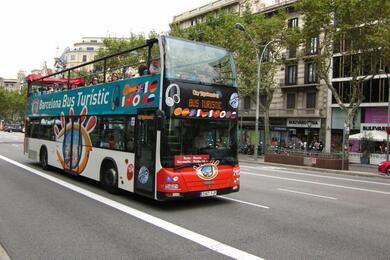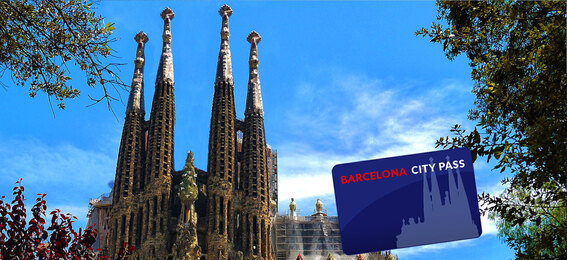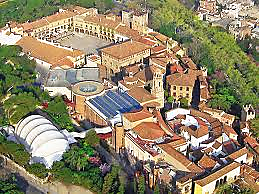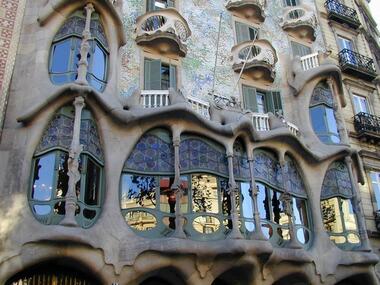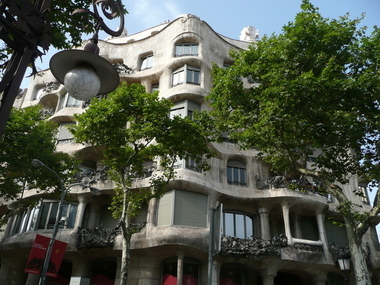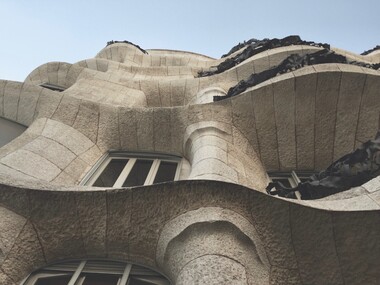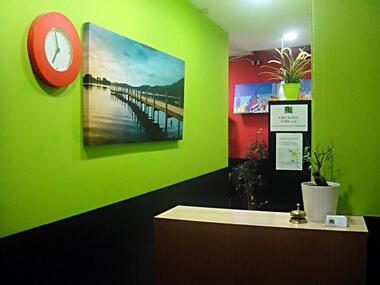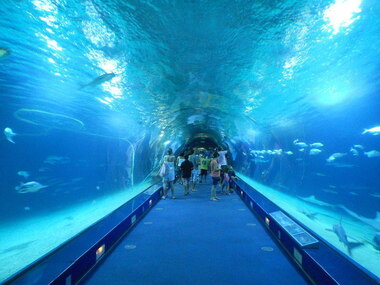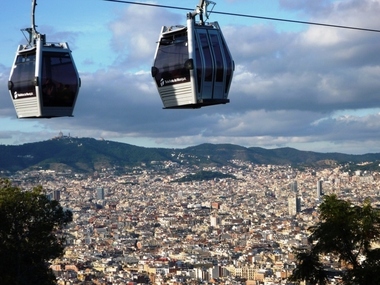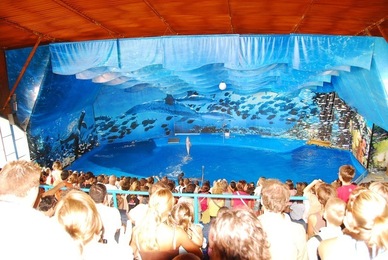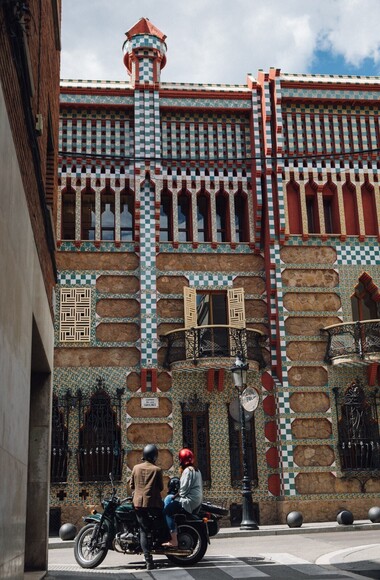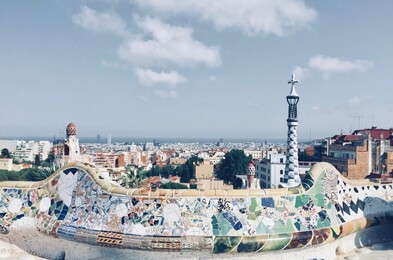
Hop on Hop off Bus Barcelona
Barcelona City Pass
Take your Barcelona trip to the next level with The Barcelona Pass. Get from A to B the breezy way on the top deck of the Hop-on Hop-off Bus, and visit two of Gaudí's most magnificent masterpieces: the Sagrada Familia and Park Güell. With this all-in-one Barcelona pass, your visit will be stress-free and fun for the whole family.Includes:
Sagrada Familia (fast-track)
Park Güell
Hop-on Hop-off Bus Barcelona
Barcelona Audio Guide
Poble Espanyol - Open Air Museum
Get to know beautiful Spain in a nutshell!
The Poble Espanyol was built in 1929, for the Barcelona International Exhibition. It's an outdoor open-air architectural museum, located on top of the Montjuic mountain and one of the few monuments that belonged to an International Exhibition still to be visited. The idea was to conceive the open air museum as a real "village" in the middle of a city, to give people a good impression of what might be an "ideal model" of a Spanish village containing the main characteristics of all towns and villages in the peninsula. For this reason, 117 buildings, streets and squares were reproduced to scale. The museum has surface area of 49,000 m2. Poble Espanyol is a 'living' village of winding narrow streets, shady corner coutyards and visual surprises showcasing the different regional architectural styles of Spain.
Tip: try to get there early in the day when it's less crowded!
Sagrada Familia
Barcelona Articket
Casa Batlló
Casa Mila By Night!
Come along to one of the most remarkable works of Antoni Gaudí!
Casa Mila or La Pedrera (stone quarry in Catalan) was the last great civil work with Gaudí performed before dedicating all his time to the construction of the Sagrada Família. This most unusual building was built between 1905 and 1910 and declared UNESCO World Heritage in 1984. Casa Mila is by far one of the most remarkable works of Antoni Gaudí. The design is taken from his own designs as well as from nature.
Casa Mila day Tickets
Casa Mila or 'La Pedrera' (meaning 'stone quarry' in Catalan) was built between 1905 and 1910 and was declared a UNESCO World Heritage landmark in 1984. Casa Mila is one of the most remarkable works of Antoni Gaudí. The eccentric design is inspired by his love to nature. Along the exterior of the building, the irregularbalconies give the impression of a series of waves. The upper floor, the attic and the extraordinary rooftop are open to visitors. Drawings, models, photographs and videos are used to portray the life of the great Gaudí, his historical and cultural context, and the artistic values and technical innovation of his work.
Picasso Museum
Find out the unexpected side of Picasso...
If you are travelling to Barcelona you definitely must see the Picasso Museum! Take your time to experience the Museum completely. The Museum is the best way to get to know Picasso and see the development from his earliest paintings as well as his late work. When walking through the museum you see the deep connection of Picasso with Barcelona: an intimate and solid relationship that was shaped in his adolescence and youth, and continued until his death.
If you like art, you must see the Picasso Museum!
Location:
Calle Montcada 15-23
08003 Barcelona
Metro to Jaume I
Fundació Joan Miró
Enter the world of renowned Catalan artist Joan Miró at The Fundació Joan Miró, and explore a treasure trove of Surrealist, Fauvist and Expressionist masterpieces in a dedicated Joan Miró museum in Barcelona.With a unique vision, and his use of bold colors and broad organic forms, Miró is one of the most influential figures in the art world. He's known for his works in painting, sculpture, mural, and ceramics. Ernest Hemingway compared Miró's painting The Farm (which he acquired), to James Joyce's Ulysses. Though he himself was not a writer, Miró did try to explain how he worked with color to communicate his ideas, "I try to apply colors like words that shape poems, like notes that shape music."
In 1968, Joan Miró himself had the idea to create the foundation. His goal was to establish an internationally recognized center in Barcelona for younger artists to engage with contemporary art. True to his original vision, the Foundation has a space ("Espai 13"), dedicated to the work of young experimental artists - as well as a large collection of works by Miró himself. Today, the Fundacio Miró Museum displays almost 15,000 pieces of art. You can find more than 8.000 drawings, 217 paintings, 178 sculptures as well as ceramics, textiles and graphic works.
FC Barcelona Stadium 'Camp Nou'
Aquarium de Barcelona
Casa Vicens
Constructed between 1883 and 1885 by order of Mr. Manuel Vicens, Casa Vicens is one of the first masterpieces of Modernism, the anticipation of the later work of Gaudí and a vivid example of the airs of aesthetic renewal that were breathed at the end From the 19th century to all of Europe.Originally, it was projected as a holiday home with a garden, in which geometric shapes and rich ornamentation, inspired by the surrounding vegetation, and this reference to natural elements is not only present on the outside of the house but also, by integrating different decorative arts - ironwork, painting, ceramics, carpentry, mural decoration, etc. - Gaudí succeeds in having nature penetrate the inside of the house, thereby creating continuity between the exterior and interior space.
If you look beyond the decoration you'll see the historicist Mudejar style as well as the forms which are Indian and Japanese in inspiration. Gaudí paid particular attention to the corners of the building, which were ridged in order to avoid the austere appearance of classical architecture. This orientalised exoticism was greeted with enthusiasm by the elite classes at the time in Barcelona. This is why it should come as no surprise that Gaudí's first building gained a much more enthusiastic reception than his later landmarks buildings, such as " La Pedrera".
3 houses of Gaudi
At the end of the 19th century and at the beginning of the 20th century Casa Batllo, Casa Mila and Casa Vicens was build by the famous architecture Gaudi. Nowadays these buildings are icons in the city because they are so unique and creative.Note: Batllo, Mila and Vicens are extremely close together
Casa Batlló
The colourful Casa Batlló, a house from the 19th century renovated in the well-known modernist style, is one of many masterpieces of Gaudí in Barcelona. The interior of the house is just as exceptional as the exterior of the building. The building has become a famous landmark in Barcelona and is open to the public. The Casa Batlló was awarded the 2004 Europa Nostra Award for the Conservation of Cultural Heritage and was inscribed on the UNESCO World Heritage List in 2005. Undoubtedly worth a visit.
Casa Mila
Casa Mila or 'La Pedrera' (meaning 'stone quarry' in Catalan) was built between 1905 and 1910 and was declared a UNESCO World Heritage landmark in 1984. Casa Mila is one of the most remarkable works of Antoni Gaudí. The eccentric design is inspired by his love to nature. Along the exterior of the building, the irregular balconies give the impression of a series of waves. The upper floor, the attic and the extraordinary rooftop are open to visitors. Drawings, models, photographs and videos are used to portray the life of the great Gaudí, his historical and cultural context, and the artistic values and technical innovation of his work.
Casa Vicens
This is the hidden gem of Barcelona that every person should see. It recently opened and the architecture will blow you away. He totally invented a new style and a new start in his career.
Parc Guell
Your visit to Barcelona would not be complete without a visit to the wonderful Park Güell! Designed by Antoní Gaudi in the early 1900’s the Park is also known as an architectural wonder and as one of Gaudi’s most colorful works. Parc Güell is located high above the Gracia district and was originally meant to be an area for Barcelona’s rich society to live, but soon it became a public playground. Nowadays the Parc is one of the top attractions of Barcelona because of its Catalan modernism architecture, its fountains, colored mosaic benches and the famous dragon at the entrance of Parc Güell. Skip the line in Europe .....
You are planning your visit to one the touristy cities in Europe? Going to Amsterdam to see Rembrandt in the Rijksmuseum, eating pasta in Rome and of course spend some time in St.Peter's Basilica, get romantic under the Eiffel Tower in Paris, or enjoy the unique structures Gaudi designed and built in Barcelona....Buy tickets for museums and sites you should most certainly see, here, in advance, and skip the line!
At this moment we offer tickets in these cities
Amsterdam
Barcelona
Paris
Rome
